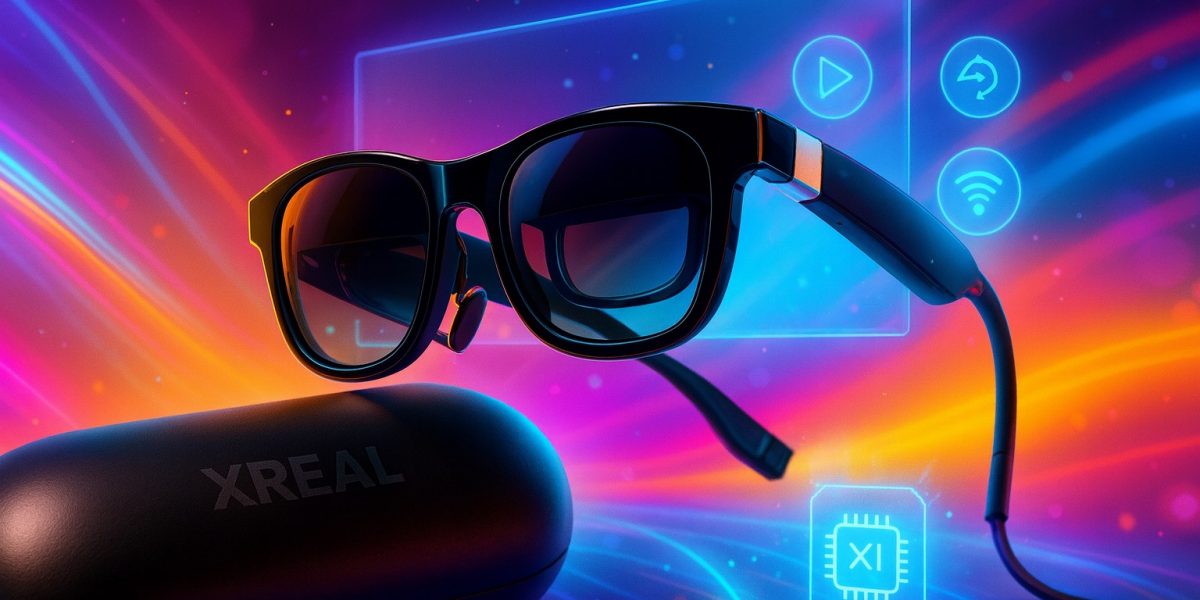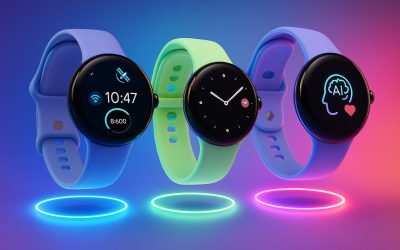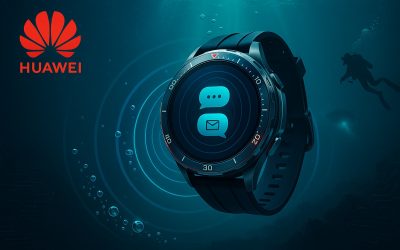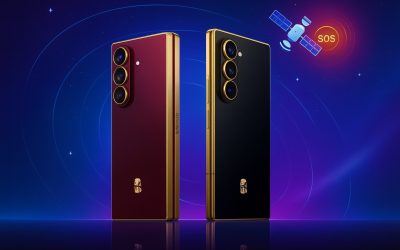Xreal’s One Pro represents a substantial upgrade to the company’s AR glasses lineup, introducing a custom X1 processing chip, enhanced display technology, and integrated Bose audio tuning. Priced at $649, these glasses deliver expanded functionality compared to previous models while maintaining the form factor of stylish eyewear. This review examines what the One Pro actually delivers, how they’re constructed, and where they stand against the Xreal Air I previously tested.

Physical Design and Wearing Experience
The One Pro maintains the aesthetic of premium sunglasses while housing augmented reality technology inside. At 87 grams, they’re slightly heavier than the Xreal Air’s 72 grams, though this difference becomes negligible during actual use. The construction combines matte plastic with magnesium alloy in a solid assembly without any flex or gaps.
The lenses incorporate electrochromic darkening with three intensity levels—from transparent to fully dark—controlled via a Quick button on the temple. This lets you switch contexts quickly: transparent mode for work environments where you need peripheral awareness, or darkened mode for immersive movie watching.
Nose pads adjust to accommodate different face shapes, while spring-loaded temples provide secure grip without uncomfortable pressure. Extended wearing sessions of two hours or more remain comfortable. The package includes a protective case and USB-C cable that tucks into the temple. User feedback indicates the fit improves on the Air model through refined nose pads and temple geometry, though the weight difference may become apparent during marathon sessions.
Display Technology and Optical Performance
Sony Micro-OLED panels (0.55 inches, 1920×1080 per eye) power the visual experience, operating at refresh rates up to 120Hz with color calibration achieving ΔE <3 for accurate reproduction. The 57° field of view translates to a virtual screen measuring 130-191 inches when viewed from two meters, depending on which mode you’re using.
Xreal’s new optical engine uses flat prismatic lenses that are 40% more compact than those in the standard Xreal One, improving sharpness while eliminating the edge blur that plagued earlier designs. Brightness peaks at 700 nits, while motion-to-photon latency hits just 3ms at 120Hz, ensuring smooth visual response.
Core Specifications:
- Display: Sony Micro-OLED, 1920×1080 per eye, 57° FOV, up to 120Hz, 700 nits peak brightness
- Processor: Xreal X1, integrated processing, 3DoF tracking
- Audio: Open-ear drivers with Bose tuning (20Hz-20kHz frequency response)
- Connectivity: USB-C (compatible with Android, iOS, Windows, macOS, Steam Deck)
- Accessories: Xreal Eye camera (12MP, 1080p/60fps, beta 6DoF support)
- Weight: 87g
- Features: Electrochromic lenses, Quick button, IPD adjustment (57-66mm or 66-75mm ranges)
The Xreal X1 chip handles 3DoF tracking—monitoring head rotation—without requiring external modules. Connectivity runs through USB-C to phones, PCs, or gaming handhelds like Steam Deck. The optional Xreal Eye camera ($99) adds photo/video capture and beta 6DoF tracking, though image quality disappoints—captured photos and videos appear noticeably softer than smartphone output.

How the Display Modes Actually Work
Three primary display modes define the One Pro experience: Anchor fixes your screen in physical space, Follow makes it track with your head movement, and Ultrawide expands to that 191-inch virtual canvas. Anchor mode proves particularly effective for stationary work—coding sessions with a floating monitor that stays positioned exactly where you left it. Follow mode suits mobile scenarios like watching content during commutes or gaming on the go. Ultrawide delivers the cinema effect, wrapping your vision in an expansive display.
Side View adds a multitasking layer—a smaller secondary screen that preserves real-world visibility while you work with virtual content.
The 3DoF tracking performs smoothly without the image drift that plagues lesser implementations. Text remains crisp enough for extended work sessions without eye strain. Gaming on Steam Deck looks impressive, though the 3DoF limitation becomes apparent in fast-paced action where full positional tracking would help. The 6DoF capability through Xreal Eye shows promise but needs refinement—the beta implementation occasionally shifts the image during movement.
Movie viewing represents the glasses’ strongest use case. The large virtual screen creates genuine wow moments, especially in darkened mode. The Nebula app (available for Android and macOS) manages settings, though it occasionally stutters with latency reaching 200ms during heavy use.
Measuring Performance Against Xreal Air
The Xreal Air gained traction through its light weight (72g) and accessible pricing ($399-449). The One Pro costs $649 (as of July 2025) but delivers meaningful improvements across multiple dimensions.
Design Evolution: The One Pro achieves a more compact profile through flat prismatic lenses—40% smaller than the birdbath optics in the Air. Electrochromic darkening (0-80% opacity range) proves more convenient than the Air’s snap-on covers. Weight increases from 72g to 87g, but fit improves through nose pads that adjust across three axes and temples angled 5° wider. The Air required swappable nose pieces, creating a less elegant solution.
Visual Capabilities: Field of view expands from 48° (Air) to 57° (One Pro)—a 19% increase. Refresh rates jump from 60Hz to 120Hz, while brightness climbs from 600 to 700 nits. The new optical engine eliminates the edge softness inherent to the Air’s birdbath design. Maximum virtual screen size grows from 130 inches to 191 inches.
Processing and Responsiveness: The integrated X1 chip replaces the external Beam module ($129) that the Air required, cutting latency from 20ms down to 3ms at 120Hz. Setup simplifies dramatically—USB-C connection without additional hardware, taking 1-2 minutes versus 5-10 minutes for Air with Beam. IPD adjustment on the One Pro uses two SKU options (57-66mm or 66-75mm ranges) with fine software tuning (±5mm), while the Air relied solely on software adjustment.
Audio Quality: Bose-tuned drivers in the One Pro (20Hz-20kHz response) deliver fuller sound than the Air (100Hz-20kHz), with bass response extending approximately 30% deeper. In noisy environments exceeding 70dB, both struggle against dedicated headphones, but the One Pro handles lower frequencies more effectively.
Functional Additions: The One Pro introduces 6DoF tracking through the Xreal Eye accessory (unavailable for Air). Side View and Ultrawide mode (up to 191 inches) remain exclusive to the One Pro. The Nebula app on Air frequently crashed with latency spikes reaching 500ms; the One Pro version runs more stably, though still imperfect.
The Air suits users exploring AR glasses on a tighter budget. The One Pro targets those prioritizing display quality, audio performance, and standalone operation without extra accessories.

Real-World Performance Assessment
After extensive testing across work, entertainment, and gaming scenarios, several patterns emerge regarding where the One Pro excels and where limitations persist.
Strengths in Practice:
The 57° FOV combined with 120Hz refresh creates convincing large-screen immersion. Whether you’re using the 130-inch or 191-inch virtual display mode, the scale genuinely transforms how you consume content. The X1 chip delivers on its 3ms latency promise—head tracking feels immediate and natural without the swimming sensation that plagued earlier AR glasses.
Bose audio tuning makes a tangible difference. The open-ear design maintains situational awareness while delivering surprisingly robust sound for something integrated into glasses temples. Bass response handles movie soundtracks and gaming audio effectively, though quiet environments still work best.
Electrochromic lens adjustment solves a practical problem elegantly. Rather than fumbling with snap-on covers when moving between bright and dark environments, you press a button and wait a few seconds. The three opacity levels handle most scenarios you’ll encounter.
Where It Falls Short:
The $649 price creates a significant barrier. This positions the One Pro firmly in premium territory, competing against budget tablets or even entry-level VR headsets. The value proposition requires you to specifically want AR glasses functionality.
6DoF tracking through the Xreal Eye remains unfinished. Beta status means exactly what it sounds like—occasional instability, tracking drift, and image shifting during rapid movements. The camera’s image quality compounds this disappointment. Photos and videos capture noticeably worse than any modern smartphone, making it a weak justification for the $99 accessory cost.
Lens glare becomes problematic in bright conditions exceeding 1000 lux. Direct sunlight or harsh artificial lighting creates reflections that interfere with the virtual display. The Nebula app, while improved over the Air version, still needs refinement—occasional lag spikes disrupt the experience.
Open-ear audio has inherent limitations. In noisy spaces—busy cafes, public transit, crowded offices—the audio simply disappears under ambient sound. You’ll want backup headphones for these scenarios.
Market Context and Competition
Alternatives like Viture or RayNeo glasses offer lower price points but sacrifice display clarity and field of view. Xreal’s teases about Project Aura and Android XR integration suggest the One Pro may serve as a platform for future software capabilities beyond current functionality.
The AR glasses category remains niche—these devices appeal primarily to early adopters, remote workers seeking portable displays, and entertainment enthusiasts who value immersive viewing over traditional screens. The One Pro targets the upper end of this market, assuming customers will pay premium pricing for refined execution.
Who Should Actually Buy These
The One Pro makes sense for specific use cases:
Remote workers needing a portable multi-monitor setup that fits in a jacket pocket. The Anchor mode genuinely enables productive work sessions in coffee shops or while traveling.
Content enthusiasts who frequently watch movies or shows during commutes or in hotel rooms. The cinema-scale experience in a lightweight package delivers real value here.
Gaming handheld owners using Steam Deck or similar devices who want a larger display without hauling a portable monitor. The 120Hz support and low latency handle fast-paced games effectively.
Tech enthusiasts interested in AR technology willing to accept beta features and iterative refinement. You’re buying into a developing platform, not a fully mature product.
The One Pro remains excessive for:
Casual users who occasionally want a bigger screen for their phone. The $649 investment doesn’t justify infrequent use.
Budget-conscious buyers better served by the Air model or competing options at lower price points.
Anyone expecting VR-level immersion. These are AR glasses—sophisticated displays, not full virtual reality headsets.
Xreal’s One Pro delivers substantial improvements over the Air through better optics, faster processing, and enhanced audio. The 57° field of view at 120Hz creates compelling large-screen experiences, while the X1 chip’s 3ms latency ensures smooth responsiveness. Electrochromic lenses and Bose-tuned audio add polish that justifies some of the premium pricing.
However, $649 represents a significant investment for glasses that still have beta features and limitations. The 6DoF tracking needs maturation, the Xreal Eye camera underdelivers, and the Nebula software requires continued refinement. These glasses suit users with specific needs—portable displays for work or entertainment—who value cutting-edge technology despite rough edges.
If budget constraints matter, the Air model remains capable at a more accessible price. But if you want the current best execution of AR glasses from Xreal, the One Pro represents that next tier of performance.




Post a comment